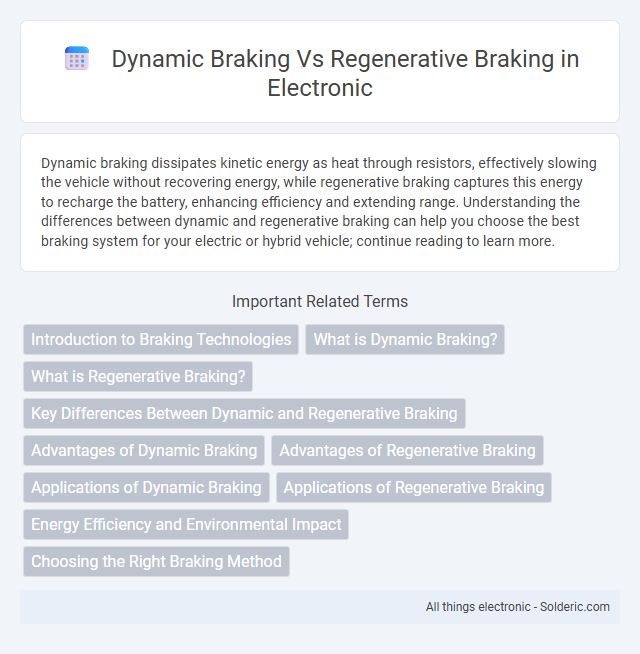Dynamic braking dissipates kinetic energy as heat through resistors, effectively slowing the vehicle without recovering energy, while regenerative braking captures this energy to recharge the battery, enhancing efficiency and extending range. Understanding the differences between dynamic and regenerative braking can help you choose the best braking system for your electric or hybrid vehicle; continue reading to learn more.
Comparison Table
| Feature | Dynamic Braking | Regenerative Braking |
|---|---|---|
| Energy Conversion | Converts kinetic energy into heat via resistors | Converts kinetic energy back into electrical energy |
| Energy Utilization | Energy dissipated as heat, not reused | Energy fed back to the power supply or battery |
| Efficiency | Lower efficiency due to energy loss as heat | Higher efficiency, recovers energy for reuse |
| Applications | Used in DC and AC motors; common in trains and industrial systems | Common in electric vehicles, hybrid cars, and modern trains |
| System Complexity | Simple setup; requires resistors and braking chopper | More complex; includes power electronics and energy storage |
| Cost | Lower initial and maintenance cost | Higher upfront cost due to advanced components |
| Heat Generation | Produces significant heat that must be dissipated | Minimal heat generated; energy conserved |
Introduction to Braking Technologies
Dynamic braking converts kinetic energy into heat through resistors, providing effective speed control without powering the electrical system. Regenerative braking captures kinetic energy and converts it back into electrical energy, enhancing energy efficiency and extending battery life in electric vehicles. Your choice between these technologies impacts overall vehicle performance and energy management strategies.
What is Dynamic Braking?
Dynamic braking converts a vehicle's kinetic energy into electrical energy, which is then dissipated as heat through resistors, effectively slowing down the vehicle without relying on friction brakes. This method is commonly used in electric and hybrid vehicles, as well as trains and industrial machines, to reduce wear on mechanical brake components. Unlike regenerative braking, dynamic braking does not store energy but instead safely releases it, making it useful when energy recovery is not feasible.
What is Regenerative Braking?
Regenerative braking is an energy recovery mechanism that captures kinetic energy during deceleration and converts it into electrical energy, which is stored in the vehicle's battery for future use. Unlike dynamic braking that dissipates energy as heat through resistors, regenerative braking enhances energy efficiency by feeding power back into the electrical system. Your vehicle benefits from improved fuel economy and reduced wear on mechanical brake components through the effective use of regenerative braking technology.
Key Differences Between Dynamic and Regenerative Braking
Dynamic braking converts the vehicle's kinetic energy into heat through resistors, dissipating energy rather than storing it, while regenerative braking recovers kinetic energy by converting it back into electrical energy for battery storage. Dynamic braking is commonly used in heavy-duty vehicles and industrial applications for effective speed control without energy recovery, whereas regenerative braking is prevalent in electric and hybrid vehicles aiming to enhance energy efficiency and extend battery life. The key distinction lies in energy management: dynamic braking wastes energy as heat, regenerative braking captures and reuses it, making regenerative braking more environmentally and economically beneficial.
Advantages of Dynamic Braking
Dynamic braking offers superior heat dissipation by converting kinetic energy into electrical energy dissipated as heat through resistors, reducing wear on mechanical brakes and extending their lifespan. It provides consistent braking force regardless of battery state, ensuring reliable performance in systems where energy storage is limited or unavailable. Your vehicle benefits from improved safety and reduced maintenance costs due to less frequent brake component replacements.
Advantages of Regenerative Braking
Regenerative braking recovers kinetic energy during deceleration, converting it into electrical energy that can recharge your vehicle's battery and improve overall energy efficiency. This system reduces wear on mechanical brakes, lowering maintenance costs and enhancing brake component longevity. By decreasing energy consumption, regenerative braking supports environmental sustainability and extends driving range in electric and hybrid vehicles.
Applications of Dynamic Braking
Dynamic braking is primarily applied in electric trains, cranes, and heavy machinery where rapid deceleration is essential to enhance safety and reduce mechanical wear. This braking technique dissipates kinetic energy as heat through resistors, making it ideal for systems without energy recovery capability. Industries relying on frequent stop-and-go operations utilize dynamic braking to maintain control and minimize maintenance costs.
Applications of Regenerative Braking
Regenerative braking is widely applied in electric and hybrid vehicles to improve energy efficiency by converting kinetic energy into electrical energy during deceleration, which is then stored in the battery for later use. This technology is also utilized in electric trains, trams, and industrial machinery to reduce energy consumption and enhance system sustainability. You benefit from prolonged battery life and reduced operational costs in systems equipped with regenerative braking.
Energy Efficiency and Environmental Impact
Dynamic braking converts kinetic energy into heat through resistors, resulting in energy dissipation and no energy recovery, which limits its energy efficiency and increases waste heat. Regenerative braking captures kinetic energy and converts it back into electrical energy, significantly improving energy efficiency by feeding power back into the battery or grid, reducing overall energy consumption. The environmental impact of regenerative braking is substantially lower due to decreased reliance on external energy sources and reduced greenhouse gas emissions compared to dynamic braking.
Choosing the Right Braking Method
Selecting the appropriate braking method depends on vehicle type and energy efficiency goals; regenerative braking recovers kinetic energy by converting it into electrical power for battery storage, enhancing range in electric and hybrid vehicles. Dynamic braking dissipates kinetic energy as heat through resistors, offering reliable stopping power without energy recovery, ideal for heavy-duty or non-electric vehicles. Evaluating system complexity, maintenance needs, and energy-saving priorities ensures optimal braking performance and sustainability.
Dynamic braking vs Regenerative braking Infographic

 solderic.com
solderic.com